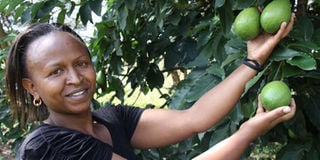To reap from avocados, follow this guide

Judy Matthews tending to some of her Avocado fruits in their farm in Nalepo, Kiserian on March 19th, 2014. PHOTO| JEFF ANGOTE
What you need to know:
- The plant requires cool to warm temperatures, with the minimum not falling below 70C and a maximum of 200C (the optimum range is 150C to 250C).
- They are highly adapted to different rainfall conditions.
- An avocado tree can grow successfully in a variety of soil types and in soil with acidic or alkaline pH levels
The avocado is cultivated over a wide range of climates, with a 2,500m altitude above sea level being the most ideal.
The tree requires cool to warm temperatures, with the minimum not falling below 70C and a maximum of 200C (the optimum range is 150C to 250C). Avocado trees are not tolerant to frost,
especially those adapted to humid tropics. The sensitivity of trees to low temperature is influenced by a wide range of factors including:
• The age of the tree, its vigour, its growth stage and its health.
• The duration and frequency of low temperature, and the speed with which they fall to near or below zero.
Temperatures that are constantly above 360C also have disastrous effects.
RAINFALL AND RELATIVE HUMIDITY
Avocados are highly adapted to different rainfall conditions, however, the rain should be an average of 1,000–1,600mm per annum and well-distributed throughout the year.
Irrigation is essential where rainfall is not adequate. Although an avocado tree cannot tolerate wet soil, it needs at least 25mm of water every week during periods of insufficient rainfall such as in
eastern Kenya.
Too much rain during flowering leads to shedding of flowers resulting in significant reduction in production. Fungal diseases also normally become problematic in very wet weather.
A short period of dry weather of up to two months usually triggers flowering especially in tropical climates not subject to marked falls in temperature.
The avocado tree needs high relative humidity at flowering (70-80 per cent), then moderate levels during the fruit swelling stage. Too much humidity encourages the proliferation of pests and
diseases such as thrips, scales, cercospora spot, scab and anthracnose.
WIND
The avocado is sensitive to strong winds, which may lead to breakage of branches or flowers and fruits drop. Whole trees may even be uprooted. Hot dry winds may cause desiccation of flower
buds or abrasions.
LIGHT
Avocado needs plenty of light, 2,000 hours of sunshine a year are sufficient. Intense radiation causes scorching of leaves and fruits.
SOIL
An avocado tree can grow successfully in a variety of soil types and in soil with acidic or alkaline pH levels, but the tree requires soil that has good drainage. Avocados are more sensitive to water-logging than citrus hence soils should be well-drained. Poorly drained soils are associated with the presence of the Phytophthora fungi, which causes root or stem end rot.
Suitable soils are medium sandy loams with a pH range of 5.5 to 6.5.
POLLINATION
An avocado tree needs to cross-pollinate with another variety for optimal fruit set. Although avocado flowers have both male and female flower parts, each part functions at a different time during the day.
The trees are grouped into Type A and Type B, depending on the time of day their male and female flower parts are reproductively viable. Planting Type A tree and Type B tree increases successful pollination if enough insect pollinators, such as bees, are present.
FERTILIZERS
To obtain good growth and high fruit yields, it is important to supply the necessary nutrients. Several factors should be taken into account when deciding on fertiliser rates.
The existing fertility of the soil should be determined. The age of the trees, fruit yields, the physical and chemical characteristics as a function of climate, determine nutrient losses through leaching,
which affects uptake by the trees.
It is advisable not to top-dress with nitrogen in the first four to five months after transplanting. After this period, 60g of 26 per cent of Nitrate (N) fertiliser should be applied every three months
when the soil is moist. About 15 to 30kg of well-rotten farm yard manure (FYM) should also be spread around the tree
The use of FYM is strongly recommended for young orchards since it improves physical characteristics of the soil and supplies nutrients to trees, promoting the uptake of micro-nutrients.
DISEASES
Avocado root rot is the most serious disease that affects the crop. The disease, which is caused by the fungal pathogen Phytophthora cinnamomi, thrives in poor drainage conditions.
Pale and wilted leaves, branch die-back and small fruits are the consequences. It has been suggested that applying a layer of gypsum and a 10 to 15cm layer of an organic, coarse mulch underneath
the avocado tree’s canopy, but several centimetres from the tree’s trunk, supplies calcium and suppresses the development of root rot.
Anthracnose, caused by the pathogen Colletotrichum gloeosporioides, infects an avocado tree’s fruit, flowers, small branches and foliage, leaving spots, lesions and decay.
This disease thrives in areas of high humidity. Pruning limbs to at least 2 feet off the ground increases air circulation at the base of the tree and removing debris from underneath the tree prevents
pathogens.
***
Frequently asked questions
Can Hass and Fuerte varieties of avocado be grown in the same climatic conditions?
Yes, they thrive well in the same environmental conditions.
In Eastern Kenya, avocadoes do well in certain pockets such as Kang’undo, Mua Hills, Kathiani (Iveti hills), parts of Mbooni, all in Machakos County, and the high potential areas of the larger Embu
and Meru counties.
These are areas where coffee is grown successfully without irrigation.
Dr Wolukau teaches at Egerton University.




